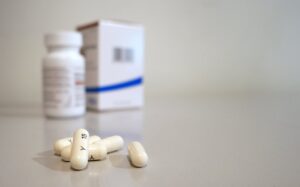Embarking on a weight loss journey can be a mix of excitement and apprehension. Maybe you’ve heard about semaglutide and are starting to feel a sense of hope that you haven’t felt in a long time. It’s a powerful tool, no doubt, but here’s something crucial to understand: the medication is only one piece of the puzzle. The other, and arguably the most important, is the role of your diet. Many people wonder if they need a special semaglutide diet plan to see results. The short answer is yes, absolutely. But it’s not about following a restrictive, punishing program. It’s about working with the medication, not against it, to make sustainable, healthy changes that will last long after you’ve reached your goal.
In this article, we’re going to dive deep into how to build a successful semaglutide diet plan. We’ll cover everything from the best foods to eat to a sample meal plan and long-term strategies. This isn’t just about what you eat; it’s about a whole new approach to food that will change your relationship with it for good.
Why Diet Matters When Taking Semaglutide

Semaglutide is a game-changer because it works by mimicking a hormone called GLP-1, which helps you feel full and satisfied while also slowing down how quickly food leaves your stomach. This leads to a natural reduction in your calorie intake. The medication is doing a lot of the heavy lifting for you by curbing your appetite, but what you choose to eat still makes a huge difference.
First, your food choices directly impact the side effects you might experience. Since semaglutide slows gastric emptying, certain foods—like those high in fat or sugar—can sit in your stomach for longer, leading to uncomfortable feelings of nausea, bloating, or heartburn. By making smarter choices, you can minimize these side effects and feel a lot better throughout your journey.
Second, your diet is key to preserving muscle mass. When you lose weight rapidly, it’s not just fat that you shed; you can also lose muscle. A diet rich in protein, combined with physical activity, is your best defense against this. Preserving muscle is vital because it keeps your metabolism running efficiently, which is a major factor in long-term weight management.
Finally, while semaglutide can give you an incredible jump-start, it’s not meant to be a permanent solution on its own. The goal is to use the medication as a bridge to a healthier lifestyle. By using this time to develop a sustainable, nutritious semaglutide diet plan, you’re setting yourself up for success long after you stop taking the medication.
What Type of Diet Should You Follow When Prescribed Semaglutide?
There is no single, one-size-fits-all diet plan for everyone on semaglutide. However, there is a general consensus among healthcare providers on the type of diet that works best. The foundation of a successful semaglutide diet plan should be based on three core principles:
- Prioritize Protein: Protein is your new best friend. It helps you feel full, supports muscle preservation, and requires more energy for your body to digest compared to other macronutrients.
- Focus on Fiber: Fiber-rich foods also contribute to satiety, help with digestion (which can be a challenge with semaglutide), and stabilize your blood sugar levels.
- Choose Healthy Fats and Carbohydrates: Not all carbs and fats are created equal. You should opt for complex carbohydrates and healthy, unsaturated fats, which provide steady energy and essential nutrients.
By focusing on these three pillars, you are building a nutritional strategy that works synergistically with the medication to maximize your weight loss while keeping you feeling good and healthy.
Read also: Semaglutide and Bodybuilding: Can You Build Muscle While on Semaglutide?
Best Foods to Eat While Using Semaglutide
So, what exactly should you be putting on your plate? Here is a breakdown of a solid semaglutide food list that will nourish your body and help you reach your goals:
- Lean Proteins: This is at the top of the list for a reason. Incorporate a protein source into every meal. Good options include:
- Chicken breast (skinless)
- Turkey
- Fish (salmon, tuna, cod)
- Lean cuts of beef or pork
- Eggs
- Tofu and tempeh
- Legumes (beans, lentils, chickpeas)
- Low-fat dairy (Greek yogurt, cottage cheese)
- High-Fiber Vegetables: These are low in calories but high in nutrients and fiber, which helps you feel full without overeating.
- Leafy greens (spinach, kale, arugula)
- Broccoli and cauliflower
- Bell peppers
- Asparagus
- Brussels sprouts
- Zucchini
- Cucumbers
- Whole Grains and Complex Carbs: These provide sustained energy and are an excellent source of fiber.
- Oats (steel-cut or rolled)
- Quinoa
- Brown rice
- Barley
- Whole-wheat bread and pasta
- Healthy Fats: Healthy fats are essential for a variety of bodily functions and can help you feel satiated.
- Avocado
- Nuts (almonds, walnuts) and seeds (chia, flax)
- Olive oil
- Fatty fish (salmon)
Foods to Avoid When Using Semaglutide

While focusing on the good stuff is most important, it’s equally helpful to know which foods might cause problems or hinder your progress. Avoiding or limiting these foods is not just about weight loss; it’s about feeling comfortable and preventing unpleasant side effects.
- High-Fat and Greasy Foods: Since semaglutide slows down digestion, these foods can be particularly hard on your system. They can lead to stomach upset, nausea, and indigestion. This includes fried foods, fatty cuts of meat, pizza, and creamy sauces.
- Sugary and Processed Foods: These foods offer little to no nutritional value and can cause a rapid spike and crash in your blood sugar. This can counteract the effects of semaglutide and leave you feeling hungrier and more lethargic. Think soda, candy, pastries, and most packaged snacks.
- Refined Carbohydrates: Similar to sugary foods, refined carbs like white bread, white pasta, and crackers are stripped of their fiber and nutrients. They digest quickly and don’t contribute to the feeling of fullness.
- Excessive Alcohol: Alcohol is full of empty calories and can also irritate your stomach and disrupt your blood sugar levels. It’s best to limit or avoid it while on semaglutide.
- Certain Gas-Causing Foods: Some vegetables, while healthy, can cause gas and bloating. If you find yourself with this side effect, you may need to limit things like broccoli, cabbage, and beans.
Weight Loss Tips When Using Semaglutide
Taking the medication is just the first step. Here are some pro tips to help you get the most out of your journey:
- Eat Slowly and Mindfully: Semaglutide makes you feel full faster. By eating slowly and paying attention to your body’s signals, you can recognize when you’re satisfied and stop eating before you feel overstuffed and uncomfortable.
- Stay Hydrated: Drinking plenty of water is essential for overall health, but it also helps with digestion and can make you feel fuller. Sometimes we mistake thirst for hunger, so having water on hand is a great strategy.
- Meal Prep is Your Secret Weapon: With your appetite reduced, you might not feel like cooking all the time. Preparing healthy meals and snacks in advance ensures you always have a good option ready, preventing you from reaching for something quick and unhealthy.
- Don’t Forget to Exercise: Remember, semaglutide is an adjunct to a healthy lifestyle. Incorporating regular physical activity, especially strength training, is crucial for preserving muscle mass and boosting your metabolism.
Weekly Diet Plan For Semaglutide Users
Creating a sample weekly meal plan can help give you a clear idea of what a healthy week on semaglutide can look like. This is just an example, and you can always mix and match based on your preferences.
Monday:
Breakfast: Scrambled eggs with spinach and whole-wheat toast.
Lunch: Grilled chicken salad with mixed greens, tomatoes, cucumbers, and a light vinaigrette.
Dinner: Baked salmon with roasted asparagus and a small serving of quinoa.
Tuesday:
Breakfast: Greek yogurt with berries and a sprinkle of chia seeds.
Lunch: Leftover salmon and veggies from Monday.
Dinner: Turkey meatballs with zucchini noodles and a simple tomato sauce.
Wednesday:
Breakfast: Oatmeal with a scoop of protein powder, a handful of walnuts, and a banana.
Lunch: Tuna salad (made with Greek yogurt instead of mayo) on whole-wheat bread.
Dinner: Lean ground beef stir-fry with broccoli, bell peppers, and brown rice.
Thursday:
Breakfast: Cottage cheese with sliced peaches.
Lunch: Leftover stir-fry from Wednesday.
Dinner: Black bean soup with a side salad.
Friday:
Breakfast: Protein smoothie with spinach, a scoop of protein powder, and almond milk.
Lunch: A large spinach salad topped with grilled shrimp and avocado.
Dinner: Chicken breast with steamed green beans and a small baked sweet potato.
Saturday:
Breakfast: A protein shake and a piece of fruit.
Lunch: Leftover chicken and vegetables from Friday.
Dinner: A cheat meal, like a small, lean hamburger with a side salad. It’s okay to have a treat as long as you don’t overdo it.
Sunday:
Breakfast: Whole-wheat pancakes with a few berries and a small amount of Greek yogurt.
Lunch: Meal prep for the week ahead! Have a light meal like a protein bar and an apple while you prep.
Dinner: Grilled chicken with a large side of roasted Brussels sprouts.
This semaglutide meal plan provides a framework for healthy eating while taking semaglutide. It’s packed with protein and fiber to keep you full and energized, and it avoids the foods that are most likely to cause discomfort.
Pro Tips for Long-Term Success
Your journey with semaglutide is a valuable opportunity to build habits that will stick. Here’s a semaglutide nutrition guide that can help you with long-term success:
- Listen to Your Body: Semaglutide will change how your body signals hunger and fullness. Pay attention to these new cues. Don’t force yourself to eat if you’re not hungry, and always stop when you feel satisfied, not stuffed.
- Hydrate, Hydrate, Hydrate: We’ve said it before, but it’s worth repeating. Water is crucial for metabolic function, digestion, and preventing side effects like constipation.
- Don’t Fear the Plateau: Weight loss isn’t always a straight line. There will be weeks when the scale doesn’t budge. This is normal. Stay consistent with your diet and exercise, and the progress will continue.
- Seek Professional Guidance: Working with a nutritionist or a medical professional can be a huge benefit. They can help you create a personalized plan and make adjustments as needed. For those of you in the Houston area, our team at PuurHW offers personalized plans to help you with your journey.
- Focus on Non-Scale Victories: It’s not just about the number on the scale. Celebrate how your clothes fit better, the increase in your energy levels, and how you’re able to move your body with more ease. These are the real markers of a successful health journey.
Conclusion
Taking semaglutide is a fantastic step toward a healthier life, but its full potential is unlocked when it’s paired with the right semaglutide diet plan. By prioritizing lean proteins, high-fiber vegetables, and healthy fats while avoiding foods that can cause discomfort, you can maximize your results and feel great while doing it. This approach isn’t just about weight loss; it’s about building a sustainable, long-term foundation for a healthier and happier you.


